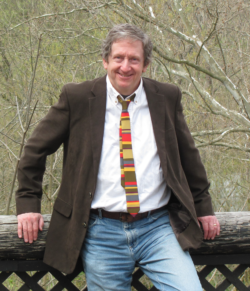
Brad Lepper is the Senior Archaeologist for the Ohio History Connection’s World Heritage Program. In addition, he has occasionally been a Visiting Professor of Sociology and Anthropology at Denison University. His primary areas of interest include North America’s Ice Age peoples, Ohio’s magnificent mounds and earthworks, and the history of Archaeology. Noteworthy research includes excavation of the Burning Tree mastodon and discovery of the Great Hopewell Road, featured in a documentary that was first broadcast on PBS in 1998.
The First Ohioans and Climate Change
Humans first entered the Ohio Valley sometime after 20,000 years ago. These hardy American Indian pioneers adapted to the New World they found and, over the succeeding millennia, shaped many aspects of their environment. Through forest clearing along with selective weeding and planting they favored some species of plants and animals and possibly drove others to extinction. Europeans arrived in the 18th and 19th centuries and rapidly accelerated those processes of environmental change. With the Industrial Revolution and the intensive burning of fossil fuels, including Ohio’s rich coal deposits, humans began to be active agents in changing the very climate of the Earth in ways that could prove to be disastrous for many species, including our own. Can humans and the civilizations we have created find ways to adapt to these profound changes or possibly even undo the damage we have caused?
The Burning Tree Mastodon and Ohio’s Ice Age
The 1989 discovery of this giant, ancient elephant-like creature opened an unprecedented window onto Ohio’s Ice Age. Archaeologists, biologists, and geologists studied the mastodon’s nearly complete remains (including its last meal) and other Ice Age animals and plants. This presentation will describe their findings and address the question of whether ancient human hunters or environmental changes drove mastodons into extinction.
The Newark Earthworks: One of the World’s Ancient Wonders
The Newark Earthworks are the largest set of geometric enclosures and mounds in the world. The work of the Hopewell people who lived in Ohio circa A.D. 1- 400, these geometric earthworks covered nearly five square miles, using more than seven million cubic feet of earth. Why did the Hopewell build such monumental works? Were they prehistoric forts or ancient American cathedrals?
The Great Hopewell Road: Ohio’s Ancient Superhighway
The Great Hopewell Road was a set of parallel earthen walls built by the Hopewell people who lived in Ohio circa A.D. 1- 400. They began at the monumental Newark Earthworks and ran southwest in a remarkably straight line. The road’s ultimate destination is a mystery, but it may have been a route of pilgrimage connecting the two grandest centers of the Hopewell world: the Newark Earthworks and the many Hopewell mounds and enclosures near Chillicothe-more than sixty miles away.
The Newark “Holy Stones”: Science, Politics, and Religion in 19th Century Ohio
The “Holy Stones” are a series of carved and polished stones bearing Hebrew inscriptions, said to have been found in the ancient mounds near Newark, Ohio in the 1860s. They were seized upon by those who believed “savage” Indians could not have built Ohio’s mounds, but have been considered frauds since the late 1800s. However, some enthusiasts have recently claimed are authentic ancient artifacts. What are the “Holy Stones?” Are they evidence of pre-Columbian visitations by ancient Hebrews? If they are clever frauds, what were the perpetrators’ motives?
Serpent Mound — An Icon of Ancient Ohio
Serpent Mound in Adams County is one of the largest and most spectacular earthen sculptures in the world. The age of the serpent is a subject of much current debate with some archaeologists arguing that it was built by the Adena culture at around 300 B.C.E. and others favoring the Fort Ancient culture at around 1100 C.E. Although much about Serpent Mound still is shrouded in mystery, ancient cave paintings in Missouri may provide a key to unlocking some of its secrets.
TO SCHEDULE A PRESENTATION , PLEASE CONTACT:
Bradley T. Lepper
blepper@ohiohistory.org
(614) 298-2064
Speaker Applications
The Ohio Humanities Speakers Bureau is closed for the rest of 2024 and is not currently accepting applications. Check back later in the year for information about the 2025 Bureau!
Interested organizations can still book talks from our United We Stand Speakers Bureau.
Speaker Fee Structure
Non-profit organizations with an annual budget under $150,000 pay a fee of $50.00.
Non-profit organizations with an annual budget over $150,000 pay a fee of $250.00.
Schools (including colleges or universities) and corporate or private entities pay a fee of $400.00.
For any questions, please contact Program Officer Melvin Barnes at mbarnes@ohiohumanities.org.
